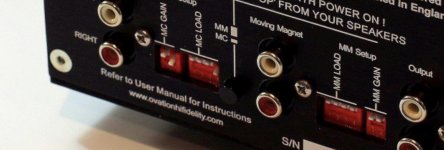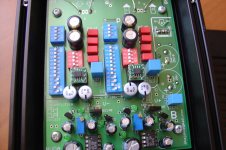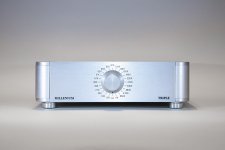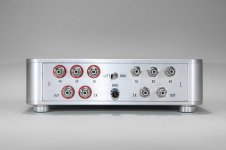I thought the OP wanted to change the loading on the fly? To me that says remotely via relays or with a rotary switch from the front panel.
That's exactly what I want Andrew.
I thought the OP wanted to change the loading on the fly? To me that says remotely via relays or with a rotary switch from the front panel. Adding DIP switches to change loading has been done for years.
To me "on the fly" means ... while the music is playing. Easy enough to take out a pair of loaded plugs and plug a new value in. 🙂
But I agree dip switches is too much trouble - given they're likely inside the case.
Andy
To me "on the fly" means ... while the music is playing. Easy enough to take out a pair of loaded plugs and plug a new value in. 🙂
But I agree dip switches is too much trouble - given they're likely inside the case.
Andy
The DIP switches on my commercial pre are accessible from the rear through a slot in the housing.
If you don’t want that, best way is with a rotary switch driving relays.
Note, using dip switches still results in some pops.
🙂
Attachments
Last edited:
If you don’t want that (dip switches), best way is with a rotary switch driving relays.
Not in my view, bonsai! 😀 I suggest the best way is the way I do it - parallel input RCA sockets for 'loaded' plugs.
Note, using dip switches still results in some pops.
Strange - given removing/inserting loaded RCA plugs doesn't (make any noises).
Andy
Ok. You do it your way, I’ll do it my way.
Anyway, I’ll sign out of this thread since clearly I’m not at the right expertise level.
Anyway, I’ll sign out of this thread since clearly I’m not at the right expertise level.
Andrew (bonsai) understood what I meant when I asked for on-the-fly changes. Ideally for me would be a remote controlled system (probably to complicated for my skills), so I can do the changes from listening position, but I can work with front rotary switch. Dip switches and other methods like paralleling input RCA is not what I'm looking for.
When I think sort of bordering on rediculous features are asked for, have to ask “why”.
How is changing the load capacitance any different than using your tone control?
Okay so you want a remote control for that too, with a cell phone app too, l get it��
How is changing the load capacitance any different than using your tone control?
Okay so you want a remote control for that too, with a cell phone app too, l get it��
Yes , arduine mega with remote controll but i never finised it because of to less time. The PCB design is on diyaudio and it is possible to use it with other remote options. The PCB had gain controll, resistance and capacity loading.Hi Ronny, I already built the phono preamp with switches. It's a MM/MC with adjustable gain (47-50-54-60dB). It is inspired from Allen Wright hybrid JFet/Tube in cascode configuration. It works flawlessly with DIP switches and since I found the sweet spot for my cartridge, I am not adjusting anymore. I was looking for on-the-fly method so I can implement it on my future projects.
That remote control with display looks interesting. Is it arduino?
View attachment 823469
I use the phono preamp of the design as my reference just with dip switch board input loading.
Sound & Comfort MC/MM Phono preamp
When I think sort of bordering on rediculous features are asked for, have to ask “why”.
How is changing the load capacitance any different than using your tone control?
Okay so you want a remote control for that too, with a cell phone app too, l get it��
Why?
First of all this is a diy website and if someone consider this as a "ridiculous" feature, some of us not. That's why we are so different.
Second of all loading of a MC cartridge is a very inexact science. Part of the cartridge loading is provided by the lead-in wiring, the resistance, and reactance of that wire must be accounted for in choosing loading values. An improperly loaded cartridge will suffer every unwanted sonic anomaly, ranging from lack of definition and bass to a very strident and screechy high end. Cartridge loading is a compromise between what works best for the cartridge and what sounds best for the listener. Not exactly tone control.
Second of all loading of a MC cartridge is a very inexact science. Part of the cartridge loading is provided by the lead-in wiring, the resistance, and reactance of that wire must be accounted for in choosing loading values. An improperly loaded cartridge will suffer every unwanted sonic anomaly, ranging from lack of definition and bass to a very strident and screechy high end. Cartridge loading is a compromise between what works best for the cartridge and what sounds best for the listener. Not exactly tone control.
Absolutely! 🙂 Well put.
Andy
Nobody is claiming that loading is not important.
What is harder to explain is why change it while the music is playing, there must be some value that suits your cartridge best.
The risk is that switching loading while the music is playing loud can blow a tweeter.
What is harder to explain is why change it while the music is playing, there must be some value that suits your cartridge best.
The risk is that switching loading while the music is playing loud can blow a tweeter.
Nobody is claiming that loading is not important.
Not sure I can agree with you there, David. 🙂
What is harder to explain is why change it while the music is playing, there must be some value that suits your cartridge best.
How else are you going to find out which value you prefer if you don't change it while the music is playing?
The risk is that switching loading while the music is playing loud can blow a tweeter.
Very true - therefore it's essential to have a method of changing loading which doesn't make 'pops'! 😀
Andy
Seem to be mixing up MM and MC loading criteria. I will join Bonsai, on this discussion, I do not listen to scratchy records anyways, old/low tech imo, have fun guys with your remote controlled phono loading projects/designs.Second of all loading of a MC cartridge is a very inexact science. Part of the cartridge loading is provided by the lead-in wiring, the resistance, and reactance of that wire must be accounted for in choosing loading values
Thanks to dipswitches I got very short signal path.
I had no problems (pops etc) with switching when music was playing - one resistor has to be fixed in circuit, the rest is parallel.
Only when I change the gain I turn down volume a little in amplifier.
I had no problems (pops etc) with switching when music was playing - one resistor has to be fixed in circuit, the rest is parallel.
Only when I change the gain I turn down volume a little in amplifier.
Attachments
Last edited:
Chnging the load on MC/MM cartridge is a very good job to discover if we can get better audio performances.
But it is necessary some lab test.
Months ago on nr. 400 of Audioreview in Italy was published an article about the coupling of MC with a step-pu trafo ( in this case a Tango 999) .
I have realized a box with an Elma 24 position switches where is possible to change the resistor put in parallel with the standard 47 kohm MM circuit.
In this way the reflected value on primary can be trimmed .
Time ago I have built a Triple step up with a trafos made for me from Sowter with three ratios:10, 20 and 40 same as venerable Tango 999.
In photo the front panel of it
I plot a lot of measurement same as 999 and the results are very interesting.
On practical use is possible to change the value on the fly without any type of noise or rumors.
And the sonic impact is very interesting.
In some phono stage , changing the input ressitor from 47kohm to 100kohm the range of reflected impedance is wider with more options.
There are two excel pages ( for 47k and 100k) with the real impedance reflected related to the value selected with the switch and the ratio on step up
Walter
But it is necessary some lab test.
Months ago on nr. 400 of Audioreview in Italy was published an article about the coupling of MC with a step-pu trafo ( in this case a Tango 999) .
I have realized a box with an Elma 24 position switches where is possible to change the resistor put in parallel with the standard 47 kohm MM circuit.
In this way the reflected value on primary can be trimmed .
Time ago I have built a Triple step up with a trafos made for me from Sowter with three ratios:10, 20 and 40 same as venerable Tango 999.
In photo the front panel of it
I plot a lot of measurement same as 999 and the results are very interesting.
On practical use is possible to change the value on the fly without any type of noise or rumors.
And the sonic impact is very interesting.
In some phono stage , changing the input ressitor from 47kohm to 100kohm the range of reflected impedance is wider with more options.
There are two excel pages ( for 47k and 100k) with the real impedance reflected related to the value selected with the switch and the ratio on step up
Walter
Attachments
As suggested, use a make before break switch. Simple to fabricate, allows multiple values or types of load resistors. My 30 year old phono amp has a switch on a front panel that has 6 positions, one being a custom socket position. Switching on the go allows for customising your sound, for rock more highs( higher load value), acustic (lower loading value) etc. Even different sound due to type of resistor, if you believe in that effect.
I concur with what others have recommended. Presuming your load and gain are determined by a single resistor:I'm looking for a "easy" and simple to implement (no programming required) solution for cartridge loading/gain change on-the-fly without having the pop sound from dip-switch or relay switching. Loading and gain adjustment will be a matter of paralleling resistors. A schematic will help a lot.
- use a make-before-break switch.
- have the highest value resistor on the main PCB

I recently built an LOMC head amp with both load & gain switches using that arrangement. I can switch both while music is playing without any clicks, pops, or transients of any sort. This may however, depend on the overall circuit topology.
Close up of the load switch:
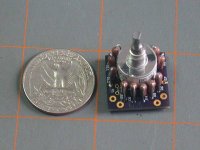
And the finished back panel:
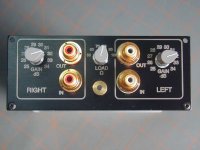
Last edited:
I concur with what others have recommended. Presuming your load and gain are determined by a single resistor:
Then wire the switch across that resistor, like this:
- use a make-before-break switch.
- have the highest value resistor on the main PCB
View attachment 824759
I recently built an LOMC head amp with both load & gain switches using that arrangement. I can switch both while music is playing without any clicks, pops, or transients of any sort. This may however, depend on the overall circuit topology.
Close up of the load switch:
View attachment 824760
And the finished back panel:
View attachment 824761
Nice project. What brand is the switch? Does is have gold plated contacts? Where to get one? Thanks.
- Home
- Source & Line
- Analogue Source
- Change cartridge loading on-the-fly
